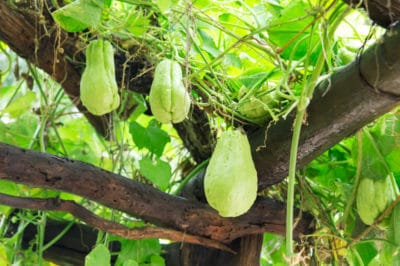A Vegetable of Many Names
In science textbooks, the chayote is known by the scientific name of Sechium edule. North American garden books often call it the “vegetable pear”. South Louisiana natives and Caribbeans know it as the mirliton. Pipinella is the name Italians choose to call chayotes. Hawaiians refer to it as pipinola.
Characteristics of Chayote
Most chayotes are 1/2 to 1 pound when mature; although, they can weigh 5 pounds each. The best fruit has smooth, edible (when cooked) outer skin. Other edible parts are the leafy tips of the tendrils, roots, and seed.
The firm inner flesh of a chayote can be compared to a dense cucumber. The subtle taste blends well with numerous foods, herbs, and spices. Here are some ways to enjoy chayote:
- Sauteed
- Eaten raw in salads
- Steamed
- Pickled
- In stir-fry
- In quiches
- In pies
- Stuffed with seafood or meat
Where Chayote Can Be Grown
To the fortunate gardener that has 150 or more frost-free days, it is worthwhile to try growing chayote. This perennial vegetable can be planted as far north as USDA Hardiness Zone 7. Chayote vines will grow on almost any structure: therefore, prepare a trellis or fence for the vines that will beautifully spread forming an ivy-like wall of green.
Preparing the Soil
A 4-foot square hill (mound) is all that is needed to plant one chayote plant. Add about 20 pounds of aged manure to the hill, mixing to a depth of 2-3 feet. Chayote plants are susceptible to root rot. Help prevent this by amending heavy clay soils with organic compost.
How to Start Chayote Plants
Starting chayote plants is not as simple as buying seed in a garden center and planting. The seed cannot be purchased in packages; however, some mail-order companies offer plants. Purchase chayotes in the produce department, then grow your own plants from the seed within the fruit.
Sprouting the Seed
Chayote, a perennial, only has to be planted once, giving the gardener many productive years of prolific harvests. When planting for the first time, in the fall buy a few large chayotes from the produce market. Store them in a dark, cool location. The seed will sprout from the bottom of the chayote and begin to grow a vine.
The vine, nourished by the chayote fruit itself, will continue to grow without added water. The entire fruit should be planted in the prepared outside location after all danger of frost is gone. If the vine grows much more than 6 inches while waiting for frost-free days, the entire vining fruit should be temporarily planted in pots in these steps:
- Fill a one-gallon pot with premium sandy soil mixture.
- Partially cover chayote with sprout out of the soil.
- Keep pot in 80°F-85°F (27°-29°C) location.
- Water occasionally.
- Keep in a sunny location.
- Move to prepared growing location when danger of frost is over.
Planting
Begin planting by digging a shallow hole (larger hole for gallon transplants). Place entire fruit (or transplant) in the hole leaving the sprout above the soil. Cover the entire fruit with soil. Water thoroughly.
Growing Needs of Chayote
A strong structure or trellis is a must for growing this prolific vegetable. In all but the first growing season vines can grow 30 or more feet long. Chayote is not picky what it grows on: even a dead tree can serve as a trellis.
Deep weekly watering is crucial to the developing fruit and lush vines. Fish emulsion or another organic fertilizer should be applied every two to three weeks during the growing season.
Chayote might be a unique cousin to squash, but it can still be plagued with some of the same pests. Use insecticidal soap or neem oil to control the pests. Nematodes can also damage the vines within two to three years. Applying 2-3 inches of pasteurized cow manure in the spring and in the summer can minimize damage.
When to Harvest
Chayote is harvested in the fall. Fruit is edible at any size, but the best time for picking is when they are small before they begin to split and germinate on the vine.
